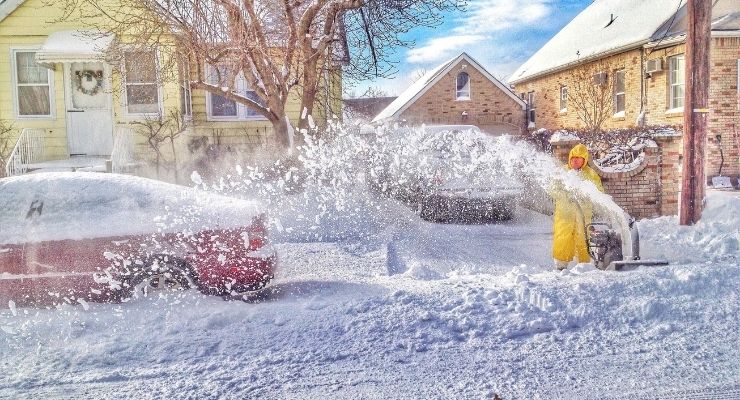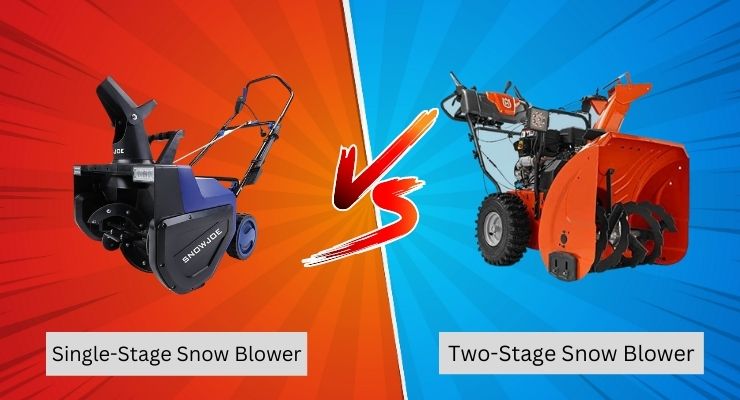Snow blowers are an invaluable tool for areas with frequent, heavy snowfall; they make clearing your driveway and sidewalks effortless! Utilizing either an auger or impeller to scoop up the flurries, this machine quickly removes snow from locations that would otherwise take hours of shoveling by hand. With a reliable snow blower in your arsenal, you can kiss those back-breaking winter days goodbye!
With so many snow blowers on the market, it can be difficult to choose which one is right for you. However, this blog post aims to simplify your shopping experience by comparing and contrasting two of the most common types: single-stage and two-stage models. We’ll cover their features in detail while offering guidance on selecting the best model according to individual needs and budget constraints.
The Single-Stage Snow Blower
A single-stage snow blower is a type of snow removal equipment that is designed to clear snow from surfaces such as driveways, sidewalks, and decks.
How Do Single-Stage Snow Blowers Work?
A single stage model works by using an auger to scoop up snow from the ground and discharge it through a chute. The auger or impeller is typically located at the front of the snow blower and is driven by a small engine.
As the snowblower advances, its auger begins to spin and draws in the snow before lifting it up into the chute. To ensure maximum convenience for operators, this chute is adjustable so that they can aim their output of snow leftward, rightward, or straight ahead depending on what suits them best.

Pros and Cons of Single Stage Blowers
For those who want a lightweight and cost-effective solution, single stage models are the way to go. Not only are they easier to manage and store than two-stage models, but they also require less upkeep.
The downside is that these machines aren’t as proficient at clearing thick, wet, or compacted snow caused by vehicle traffic.
Best Use Cases for a Single-Stage Snow Blower
If you’re looking for a snow blower that can tackle smaller areas like driveways, decks, and sidewalks with ease then single-stage ones are a perfect choice.
They may not be as powerful as two-stage snow blowers but they certainly make up in effectiveness when it comes to clearing small surfaces of packed or wet snow. Plus their maintenance and operation are a breeze!
Some of the best use cases for a single-stage snow blower include:
- Driveways and sidewalks: Whether it’s a driveway or sidewalk, single-stage snow blowers are the ideal choice for effortlessly and efficiently removing small amounts of snow. Their compact design makes them easy to maneuver in tight spaces and their powerful main auger quickly clears away large accumulations of snow with minimal effort.
- Clearing decks and patios: Single-stage snow blowers are an ideal choice for decks and patios due to their light weight, portability, and ease of movement. Easily transportable around any surface area or obstacle, they make clearing these outdoor surfaces a breeze!
- Clearing light, powdery snow: If you are dealing with heavy, wet snowfall, single-stage snow blowers just won’t do the trick – they lack the same power and performance as two-stage models. However, they are very effective at clearing light, powdery snow and can be a good choice for homeowners who live in areas with light snowfall.
All in all, single-stage snow blowers are an optimal decision for those homeowners who regularly need to shovel out small patches of snow and desire a user-friendly machine that requires minimal upkeep.
The Two Stage Snow Blower
A two-stage snowblower is an advanced machine designed to provide efficient and effective snow removal from driveways, patios, walkways, and more frequently, large yards and anything with uneven surfaces, such as gardens.
Through the combination of an auger and impeller that work in tandem, this robust equipment can quickly clear even heavy accumulations with minimal effort on your part.

How Do Two Stage Snow Blowers Work?
Equipped with a rotating auger and impeller mechanism, two-stage snow blowers are designed to effortlessly scoop up the toughest of winter elements – snow and ice.
While the auger is shaped like a spiral blade that collects these materials from your driveway or walkway, it’s the impeller fan-like blade that propels them out through its discharge chute. With this powerful combination, you can clear away inches of thick frozen precipitation in no time!
As the snow blower runs, its auger and impeller work in tandem to clear any accumulation of snow. The auger first cuts through the snow and ice, breaking it up into smaller pieces, and then the impeller propels the snow out of the chute.
Best Use Cases for a Two-Stage Snow Blower
If you’re dealing with a large or lengthy driveway in an area prone to heavy snowfall, investing in a two-stage snow blower is the perfect solution for your winter weather woes.
Engineered to manage a substantial amount of snow and icy conditions, these snow blowers can effectively clear large paths with just one pass.
By working together, the auger and impeller can push snow out of their path to provide a more effective clearing process – even in deeper snows.
With sizeable driveways or areas that regularly receive heavy snowfall, a two-stage snow blower is the most efficient option for quickly removing the accumulation of snow from your driveway and other outdoor surfaces.
Comparison of Single Stage vs Two Stage Snow Blowers
Size
Single-stage snow blowers are typically smaller and lighter than two-stage snow blowers. They have a smaller clearing width, typically around 20-24 inches, and are designed for smaller areas such as sidewalks and small driveways.
Two-stage snow blowers are larger and heavier than single-stage models. They have a wider clearing width, typically around 24-30 inches, and are suitable for larger areas such as long driveways and large yards.
Power
Single-stage snow blowers can be powered by either gas or electricity. Gas models typically have a horsepower range of 4-7, while electric snow blowers have an amp range of 12-15.
Two-stage snow blowers are typically powered by gas, with a horsepower range of 6-14.

Capacity
Single-stage snow blowers are great if you need something with a lower plowing capacity, typically ranging between 300-700 pounds per minute.
But for the heavier stuff, two-stage models can really get the job done efficiently; they have an impressive plowing capacity of around 800 to 1000 pounds per minute.
Height of Snow
It is essential to understand that the height of snow handled by a snow blower does not distinctly differentiate between single-stage and two-stage models. Therefore, it’s critical to evaluate each particular model for its individual capabilities rather than solely considering the type of machine when making your decision.
Multiple versions exist in both categories with varying power levels and capacities; thus, consider every factor before you purchase one.
Compared to single-stage snow blowers, two-stage models are much more capable when it comes to clearing large accumulations of snow. While single-stage units can typically manage up to 8 inches of height, two-stages can easily take care of heights as great as 20 inches.
Keep in mind that the snow-clearing capacity of a snow blower is also affected by factors like the clearing path width and engine horsepower.
Cost
In terms of cost, single-stage snow blowers are generally more budget-friendly and typically range from $300-$800. On the other hand, two-stage models tend to be pricier with costs spanning from $800-$1500.
Clearing Surface
With its auger sitting closer to the ground, a single-stage blower can quickly clear away snow from flat and paved surfaces with little resistance. Unfortunately, this limits these units’ ability to traverse more difficult and uneven terrain; something that two-stage models are capable of doing.
Using a single-stage blower on gravel driveways can be hazardous, potentially causing damage to your machine and even harming bystanders due to the stones flying around. Therefore, it is best practice to employ two-stage machines when working with loose surfaces in order to avert the potential risk of injury.
Extra Features
Single-stage machines tend to be simple and more bare-bore, with limited features.
Dual stage snow blowers on the other hand tend to be equipped with comfort features such as heated handles, electric start, power steering, big headlights, and so on.

Direct Comparison
Single-Stage Snow Blower:
Pros
- Lightweight and easy to maneuver
- Lower cost
- Suitable for smaller driveways and sidewalks
- Can be battery operated
- Better at handling a few inches of snow
Cons
- Limited in terms of snow clearing capacity (usually up to 6-8 inches)
- Not suitable for heavy or wet snow
- Not as durable as two-stage models
- Won’t work on gravel or uneven surfaces
Two-Stage Snow Blower:
Pros
- Can clear larger areas and deeper snow (up to 18-20 inches)
- More powerful and efficient
- Suitable for heavy and wet snow
- More durable
- May have power steering and other comfort features
- Electric start and more accessories
Cons
- Heavier and harder to maneuver
- Higher cost
- May be overkill for smaller driveways and sidewalks
- Usually, gas powered with all the extra maintenance
Conclusion
When shopping for a snow blower, there are several factors to consider in order to ensure that you make the right purchase.
Single-stage and two-stage snow blowers both have their advantages and disadvantages, so it is important to assess your needs and budget before making a decision.
Whichever snow blower you decide to go with, make sure that it meets your requirements in terms of cost, performance, durability, and other features.

